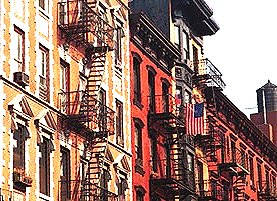N E I G H B O R S A S S O C I A T I O N ( L I N A )
t e n e m e n t s
Tenements are to Little Italy what brownstones are to the Upper West Side. Lining the area's streets and sheltering the majority of its residents, they give the area its distinctive architectural character.

![]() Little Italy's tenements are a mix of pre-Law, Old Law and New Law models, the different categories indicating their dates of construction and, accordingly, their varying designs. Developments in tenement design over the nineteenth and early twentieth centuries reflect choices made by landlords, architects, legislators and social reformers, groups whose disparate interests converged in seeking to house the lower classes.
Little Italy's tenements are a mix of pre-Law, Old Law and New Law models, the different categories indicating their dates of construction and, accordingly, their varying designs. Developments in tenement design over the nineteenth and early twentieth centuries reflect choices made by landlords, architects, legislators and social reformers, groups whose disparate interests converged in seeking to house the lower classes.
Until the mid-nineteenth century, New York City's poor lived in squatter shacks or rundown older buildings divided up into small cubicles. The latter group of structures, referred to derisively as "rookeries," were notoriously cramped, unhygenic, and poorly ventilated -- architectural proof of their landlords' desire to "stow the greatest number of human beings in the smallest space."
By the second half of the nineteenth century, with the steady growth in immigration, land speculators erected new buildings specifically to house poor arrivals to the city. Known as tenements, the basic elements of their design were dictated by practical structural constraints and the convention of the 25-by-100-foot building lot. From four to six stories tall, they grouped four apartments to a floor, whose dark, unventilated interior rooms connected like cars on a train (hence the expression "railroad flat").
In an effort to improve living conditions, the city passed its first comprehensive housing law in 1867: the Tenement House Act. For the first time, the tenement was legally defined and regulated. Among other improvements, tenements were required to be equipped with fire escapes and toilets (at least one for every twenty tenants).
A decade later, the Tenement House Act of 1879 inaugurated the reign of the dumbbell tenement, so called for its distinctive shape when seen from above. The exterior walls of such buildings are indented between the front and back apartments, creating air shafts between adjacent buildings. Thousands of dumbbell tenements were erected in Little Italy and the Lower East Side, as exemplified by the few blocks shown on this old land map.